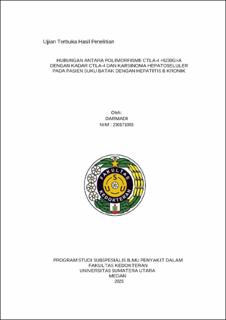| dc.description.abstract | Background. Cytotoxic T-lymphocyte antigen-4 (CTLA-4) is the most studied checkpoint inhibition molecule that has the potential to develop HCC cases. CTLA-4 levels can be influenced by polymorphisms in the CTLA-4 gene, which can vary among ethnicities/races.
Objective. To analyze the relationship between CTLA-4 +6230 G>A polymorphism with HCC and CTLA-4 levels in chronic hepatitis B patients of Batak ethnicity.
Methods. The study design used was a case-control. Inclusion criteria include chronic hepatitis B patients with HCC (case group) and without HCC (control group), Batak ethnicity, aged > 18 years, cooperative and willing to participate by signing the consent form after explanation (informed consent). Exclusion criteria include the consumption of immunomodulator/immunosuppressant drugs in the past month; patients with HIV, Hepatitis C, chronic kidney disease, autoimmune diseases, other malignancies; and pregnant women. An interview, physical examination, abdominal ultrasound, and blood draw were conducted. Measurement of serum CTLA-4 levels using the ELISA method and examination of CTLA-4 +6230 G>A polymorphism using the real-time PCR method. Data analysis was performed using statistical programs with chi-square tests, unpaired T-tests, One-way ANOVA, and binomial logistic regression. The significance of the statistical test results is determined based on a p-value of <0.05.
Results
There was a significant relationship between CTLA-4 levels, HBV DNA, ALT, and CTLA-4 +6203G>A polymorphism with HCC. Liver cirrhosis increased the risk of experiencing HCC by 7.6 times (p<0.001). High levels of HBV DNA significantly increased the risk of developing HCC by 2.31 times (p=0.024). High CTLA-4 significantly increased the risk of experiencing HCC by 2.16 times (p=0.040). Old age was at 1.65 times higher risk of experiencing HCC (p=0.043). Subjects with the CTLA-4 +6230G>A polymorphism with the G allele significantly increased the risk of experiencing HCC by 1.45 times (p=0.046). There was a significant difference in serum CTLA-4 levels among genotypes of the CTLA-4 +6230G>A polymorphism. CTLA-4 levels were significantly higher in hepatitis B patients with GG and AG genotypes compared to AA (p<0.001).
Conclusions
There was a significant relationship between the G allele of CTLA-4 +6230G>A polymorphism, high CTLA-4, liver cirrhosis, high ALT, high HBV DNA, old age, and HCC in chronic hepatitis B patients. | en_US |


